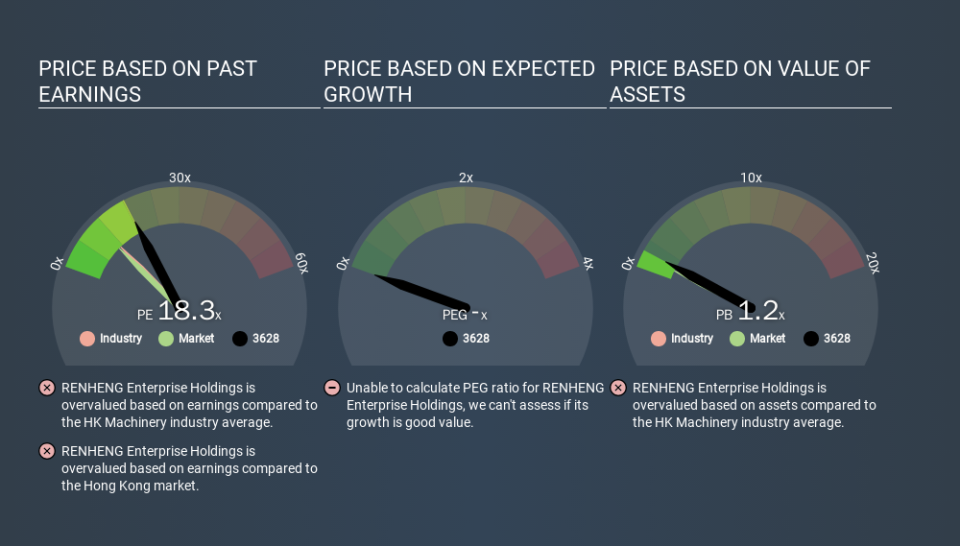What Is RENHENG Enterprise Holdings's (HKG:3628) P/E Ratio After Its Share Price Tanked?

To the annoyance of some shareholders, RENHENG Enterprise Holdings (HKG:3628) shares are down a considerable 36% in the last month. Even longer term holders have taken a real hit with the stock declining 26% in the last year.
Assuming nothing else has changed, a lower share price makes a stock more attractive to potential buyers. While the market sentiment towards a stock is very changeable, in the long run, the share price will tend to move in the same direction as earnings per share. The implication here is that long term investors have an opportunity when expectations of a company are too low. Perhaps the simplest way to get a read on investors' expectations of a business is to look at its Price to Earnings Ratio (PE Ratio). A high P/E ratio means that investors have a high expectation about future growth, while a low P/E ratio means they have low expectations about future growth.
View our latest analysis for RENHENG Enterprise Holdings
How Does RENHENG Enterprise Holdings's P/E Ratio Compare To Its Peers?
We can tell from its P/E ratio of 18.32 that there is some investor optimism about RENHENG Enterprise Holdings. The image below shows that RENHENG Enterprise Holdings has a higher P/E than the average (11.2) P/E for companies in the machinery industry.
RENHENG Enterprise Holdings's P/E tells us that market participants think the company will perform better than its industry peers, going forward. Clearly the market expects growth, but it isn't guaranteed. So investors should delve deeper. I like to check if company insiders have been buying or selling.
How Growth Rates Impact P/E Ratios
Earnings growth rates have a big influence on P/E ratios. When earnings grow, the 'E' increases, over time. Therefore, even if you pay a high multiple of earnings now, that multiple will become lower in the future. And as that P/E ratio drops, the company will look cheap, unless its share price increases.
RENHENG Enterprise Holdings's 243% EPS improvement over the last year was like bamboo growth after rain; rapid and impressive. Unfortunately, earnings per share are down 23% a year, over 5 years.
Remember: P/E Ratios Don't Consider The Balance Sheet
Don't forget that the P/E ratio considers market capitalization. In other words, it does not consider any debt or cash that the company may have on the balance sheet. In theory, a company can lower its future P/E ratio by using cash or debt to invest in growth.
While growth expenditure doesn't always pay off, the point is that it is a good option to have; but one that the P/E ratio ignores.
How Does RENHENG Enterprise Holdings's Debt Impact Its P/E Ratio?
RENHENG Enterprise Holdings has net cash of HK$48m. This is fairly high at 29% of its market capitalization. That might mean balance sheet strength is important to the business, but should also help push the P/E a bit higher than it would otherwise be.
The Verdict On RENHENG Enterprise Holdings's P/E Ratio
RENHENG Enterprise Holdings's P/E is 18.3 which is above average (10.6) in its market. The excess cash it carries is the gravy on top its fast EPS growth. So based on this analysis we'd expect RENHENG Enterprise Holdings to have a high P/E ratio. What can be absolutely certain is that the market has become significantly less optimistic about RENHENG Enterprise Holdings over the last month, with the P/E ratio falling from 28.8 back then to 18.3 today. For those who don't like to trade against momentum, that could be a warning sign, but a contrarian investor might want to take a closer look.
When the market is wrong about a stock, it gives savvy investors an opportunity. If the reality for a company is better than it expects, you can make money by buying and holding for the long term. Although we don't have analyst forecasts shareholders might want to examine this detailed historical graph of earnings, revenue and cash flow.
Of course, you might find a fantastic investment by looking at a few good candidates. So take a peek at this free list of companies with modest (or no) debt, trading on a P/E below 20.
If you spot an error that warrants correction, please contact the editor at editorial-team@simplywallst.com. This article by Simply Wall St is general in nature. It does not constitute a recommendation to buy or sell any stock, and does not take account of your objectives, or your financial situation. Simply Wall St has no position in the stocks mentioned.
We aim to bring you long-term focused research analysis driven by fundamental data. Note that our analysis may not factor in the latest price-sensitive company announcements or qualitative material. Thank you for reading.

